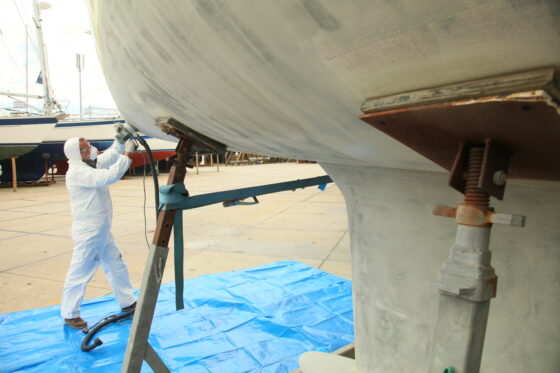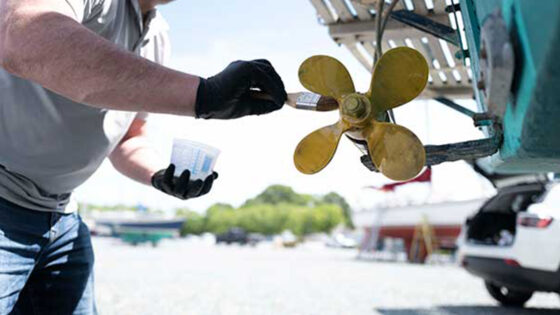
Antifouling innovations: a plan for ecological boating

The antifoul game is changing – from biocide-free solutions to UV panels and robotics – new antifouling innovations are placing a renewed focus on an economical and ecological boating future, writes Alex Smith.
Marine coatings, particularly those used below the waterline, have an extremely important job to do. With around 4,000 potential fouling organisms in the world’s oceans, from algae and anemones to barnacles and mussels, effective antifoul practices are vital. Antifouling does not just maintain hull efficiency and minimise costs but can also help prevent the spread of non-native species to other regions.
Given that a heavily fouled hull can increase drag by around 40 per cent, the environmental impact in terms of emissions is also critical. According to Chris Birkert, marine segment manager at AkzoNobel, a heavily fouled container ship could potentially “increase its CO2 emissions in a single year by up to 16,000 tonnes for a 10 per cent speed reduction and up to 64,000 tonnes if you want to retain its original speed”.
Effective coatings and antifoul innovations are vital to sustainable boating, both from a financial and an ecological perspective. And while, in the past, the relative absence of legislation regarding toxic content in antifoul has made that job easier, the game has changed. With public attitudes, political intent and international legislation now broadly aligned in their commitment to cleaner seas, both commercial shipping and recreational boating are searching for biocide-free solutions that are as ‘friendly’ as they are effective.

Stay slippy
Silicone-based foul-release coatings have been garnering plenty of attention and with good reason.
Rather than releasing harmful biocides into the environment, silicone-based coatings are designed to create a slippery surface, thereby preventing the attachment of organisms and helping hulls self- clean underway. With around two decades of effective use behind them, Propspeed’s biocide-free, silicone- based coatings are now available for transducers, as well as props, running gear and subsurface metals. Hempel’s Silic One is another biocide-free fouling release system, which is based on a combination of silicone and hydrogel. While longevity is not generally as strong as other techniques, most mainstream silicone foul-release coatings exhibit an effective service life of between 12 and 24 months.

Metal frame
Coppercoat uses a combination of a solvent-free water based epoxy resin and high purity (99 per cent) copper. Each litre of resin is impregnated with two kilos of ultra fine copper – the maximum allowed by law. On immersion, sea water attacks the exposed pure copper powder, causing the formation of cuprous oxide. This antifouling agent deters growth until the surface degrades further to become cupric hydrochloride. This final copper form is highly unstable, and is washed away by the movement of the yacht, thereby removing any accumulating silt or slime underway.
Let there be light
Ultraviolet (UVC) light is a promising technology in the field, particularly in the form of flexible light-emitting panels. AkzoNobel has been involved with Philips in the development of its RunWell panels. Testing on commercial vessels has shown that UV light emitted from a hull’s surface can present an effective deterrent to biofouling in a range of locations, in a range of conditions, whether a hull is in motion or not.
Birkert explains: “What we’re looking at is embedding UVC LEDs into a highly mobile, highly fluid material that you can stick onto pretty much any shape. Power requirements are very minimal, and these things could potentially last ten years without replacement.” With trials expected in the leisure industry within the next five years, it’s hoped that UV light could play a major part in the removal of biocides from the antifoul equation.
Second skin
Biomimetic technologies attempt to make a boat hull ‘invisible’ to fouling organisms by mimicking a variety of natural foul-resistant surfaces, whether that involves coral tentacles or the skin of a whale or dolphin.
Shark skin, with its overlapping plates and parallel ridges, has garnered particular attention – and as 3D printing and laminate technologies continue to develop, new materials and application techniques are likely to make biomimetic solutions a possibility.
Sound travels
Ultrasonic antifouling systems use transducers to emit simultaneous bursts of ultrasonic sound waves in multiple frequencies. The theory is that the alternating positive and negative pressures create microscopic bubbles that implode against the surface, destroying the very microorganisms that form the building blocks for bio fouling.
Though concerns over the long- term impact of ultrasound on key mammalian species including whales and dolphins have been raised, studies have drawn no conclusive evidence to support those concerns and ultrasonic systems remain in use both on steel-built commercial vessels and as standalone and supplementary systems on recreational craft.
A new age of integration
Gone are the days when paint manufacturers confined themselves solely to coatings. A more dynamic 360 approach is also coming into play. According to Stein Kjølberg, global category director, hull performance, at Jotun Performance Coatings, the change in how users are approaching their fouling problem in itself is a critical innovation.
“In the commercial world, the onset of fouling is always discovered too late, leading to inflated fuel costs for an average of six months before remedial action is taken. So it makes sense that effective antifouling systems need to involve a combination of the products we supply, the advice we give and the cleaning techniques we use,” Kjølberg says.
Jotun’s industry-first ‘hull skating’ antifoul robot could bring extra flexibility to fouling response protocols. Its integrated Hull Keeper system takes full advantage of the improvements in ‘big data’ to go even deeper. According to Jotun, it assesses the data in relation to a vessel’s type, route and activities, enabling ship owners to take early action against fouling and to remain properly informed about where to clean and where to sit idle, so they can minimise the severity of the fouling challenge.

This data-driven approach is strongly endorsed by other industry players too – not least, AkzoNobel, which states that its integrated Intertrac Hullcare system can achieve “step-change reductions in CO2 emissions of up to 34,000 tonnes and fuel savings of €4.6million” for a ship owner over a ten-year period.
Robotic range
The advent of the integrated service package looks likely to make a major impact on the leisure market as well. After all, if an owner wants a clean, fast and efficient hull for five years, then rather than buying a standalone antifoul coating, it makes sense to invest in a subscription-based service that spreads the cost and improves consistency.
According to Phil Horton, environment and sustainability manager at the RYA, such a service already exists in the Baltic states, where boats with silicone coatings are able to clean their hulls in marinas simply by driving through robotic car wash-style in- water jet systems.
Horton notes the sheer scale of the business opportunities available to paint manufacturers who are willing to cooperate more closely with marina operators and cleaning companies.
“With sustainability now providing such a strong driving force, innovation is really starting to happen, not just in relation to the antifoul coatings themselves but also in relation to the way people think about maintaining their hulls.
“There are still strides to be made in terms of independent testing so that businesses and consumers are able to assess how well each new technology works but with everyone now moving in the same direction, I have no doubt that we are on the cusp of a more elegant, more engineered, more carefully considered approach that takes proper account of environmental concerns as well as performance,” says Horton.
This article was first published in MIN‘s print edition for Spring 2022.
